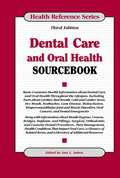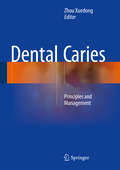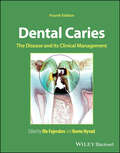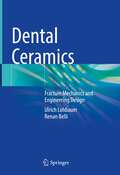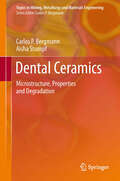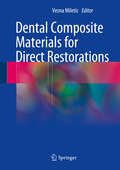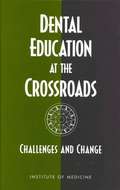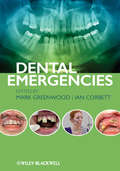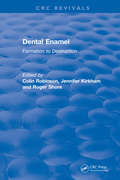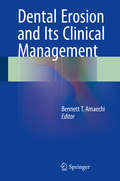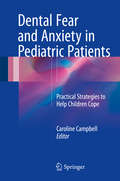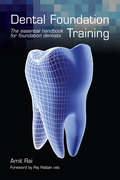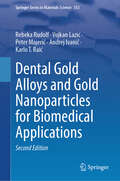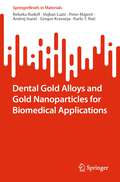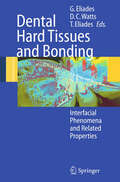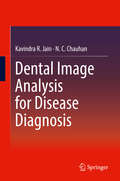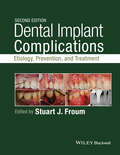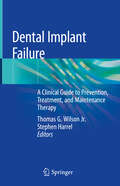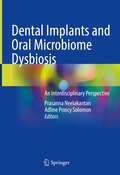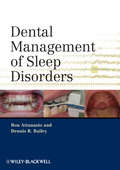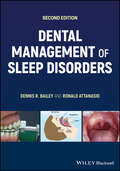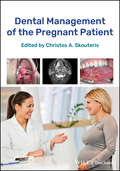- Table View
- List View
Dental Care and Oral Health Sourcebook (3rd Edition)
by Amy L. SuttonThe compilation of documents and excerpts from publications by government agencies and professional organizations provides general readers with information about the structure of the mouth and teeth, age-related oral health concerns, and the link between poor oral health and systemic disease. It also describes common dental concerns, oral and maxillofacial surgery, endodontic and root canal treatments, and orthodontic and cosmetic procedures. A glossary without pronunciation guides is provided. Annotation ©2009 Book News, Inc., Portland, OR (booknews.com)
Dental Caries
by Zhou XuedongThis book is a well-illustrated and comprehensive guide to the etiology, clinical manifestations, diagnosis, clinical management and prevention of dental caries. Current challenging problems in the field are analyzed and the latest research findings, presented. After an introductory chapter on tooth development, the relationships of biofilm and saliva to dental caries and the significance of the balance between demineralization and remineralization for the development of carious lesions are discussed. Subsequent chapters address the state of the art in diagnosis and treatment, the implications of disease burden for prevention and the association between systemic diseases and dental caries. Dental Caries: Principles and Management is intended for dental school students, practicing dentists and researchers in dentistry.
Dental Caries: The Disease and its Clinical Management
by Ole Fejerskov Bente NyvadAuthoritative and comprehensive resource on the disease process and clinical management of dental caries. Dental Caries: The Disease and Its Clinical Management, 4th Edition maintains the same focus on high-level coverage of the disease etiology and process, clinical assessment and prognosis and wider public health issues connected with dental caries management, including an enhanced focus on caries control. Fully updated throughout, the chapters that discuss theory emphasize how the knowledge can be applied in both the clinic and in the public health domain to improve oral health. The new edition also includes up-to-date and validated diagnostic and management options for caries whilst ensuring that the tools provided allow practitioners to serve the needs of different socio-economic populations. All sections are complimented by high-quality color photographs, clear line drawings and references for further study. With contributions from international experts in research and clinical practice, Dental Caries includes information on: Acquisition and establishment of the oral microbiome, metabolism of the microbiome in caries, and the essential role of saliva for dental caries and erosionInitiation and progression of dental caries in dental hard tissues and the relationship between sugar, diets, and dental cariesThe caries control concept and consequences for minimally invasive management of cariesCaries control in children, adults, and the elderly, including root surface caries and oral health care in the elderlyImplication of caries control for the dental profession, including best practices for assessment of lesion activity, prognosis and risk for developing dental caries Dental Caries, Fourth Edition is an unrivaled guide to tooth decay, and a must-have resource for undergraduate and postgraduate students in dental public health, paediatric and restorative dentistry as well as all practitioners looking to develop their clinical skills.
Dental Ceramics: Fracture Mechanics and Engineering Design
by Ulrich Lohbauer Renan BelliThis book is an evidence-based update on recent most significant advances in dental ceramics, specifically related to the relationships between composition, microstructure and mechanical behavior. Readers will find an introduction to the chemistry of dental ceramics as well as information about the technological progress and practical requirements restorative materials need to satisfy for long-lasting structural integrity. The book uses mechanistic approaches to address failure mechanisms from controlled experiments thus providing the tools for the application of sound research methodologies in the field. It is targeted for researcher and dentists interested in the field of dental ceramic materials and fracture mechanics.
Dental Ceramics: Microstructure, Properties and Degradation
by Aisha Stumpf Carlos BergmannThis book gives an introduction to the mechanical behavior and degradation of dental ceramics and guides the reader through their performance under effect of oral environments. It addresses the different kinds of dental ceramics, their properties, degradation and mechanical aspects with less emphasys on the physics and chemistry involved, which makes the reading interesting for beginners in the field. In each chapter, the reader will learn about the mechanical behavior of dental ceramics and each phenomenon involved in their application, besides finding some practical examples of their use in dental clinics, their manufacturing procedures and types of degradation. The clear language and the application-oriented perspective of the book makes it suitable for both professionals and students who want to learn about dental ceramics.
Dental Composite Materials for Direct Restorations
by Vesna MileticThis book covers both basic scientific and clinically relevant aspects of dental composite materials with a view to meeting the needs of researchers and practitioners. Following an introduction on their development, the composition of contemporary composites is analyzed. A chapter on polymerization explains the setting reactions and light sources available for light-cured composites. The quality of monomer-to-polymer conversion is a key factor for material properties. Polymerization shrinkage along with the associated stress remains among the most challenging issues regarding composite restorations. A new classification of dental composites is proposed to offer more clinically relevant ways of differentiating between commercially available materials. A review of specific types of composites provides an insight into their key issues. The potential biological issues of dental composites are reviewed in chapters on elution of leachable substances and cariogenicity of resin monomers. Clinical sections focus on material placement, finishing procedures, and the esthetics and clinical longevity of composite restorations. Bonding to tooth tissues is addressed in a separate chapter, as is the efficiency of various composite repair methods. The final chapter discusses future perspectives on dental composite materials.
Dental Education at the Crossroads: Challenges and Change
by Committee on the Future of Dental EducationSix dental schools have closed in the last decade and others are in jeopardy. Facing this uncertainty about the status of dental education and the continued tension between educators and practitioners, leaders in the profession have recognized the need for purpose and direction.This comprehensive volume--the first to cover the education, research, and patient care missions of dental schools--offers specific recommendations on oral health assessment, access to dental care, dental school curricula, financing for education, research priorities, examinations and licensing, workforce planning, and other key areas.Well organized and accessible, the book Recaps the evolution of dental practice and education. Reviews key indicators of oral health status, outlines oral health goals, and discusses implications for education. Addresses major curriculum concerns. Examines health services that dental schools provide to patients and communities. Looks at faculty and student involvement in research. Explores the relationship of dental education to the university, the dental profession, and society at large. Accreditation, the dental workforce, and other critical policy issues are highlighted as well.Of greatest interest to deans, faculty, administrators, and students at dental schools, as well as to academic health centers and universities, this book also will be informative for health policymakers, dental professionals, and dental researchers.
Dental Emergencies
by Mark Greenwood Ian CorbettDental emergencies are common and require rapid response. Order today and keep readily accessible in your dental practice! Filled with clinical examples and step-by-step procedures, Dental Emergencies covers the full range of both common and complex traumatic injuries, pain, and oral lesions. From clinical examination and assessment of potential complications to key considerations in pain management, acute oral medical and surgical conditions, restorative emergencies, treating special needs patients, and beyond, you get a comprehensive reference that: distills essential information on dental emergencies offers succinct, practical instruction for immediate treatment highlights conditions for referral and much more!
Dental Enamel Formation to Destruction (CRC Press Revivals)
by Colin Robinson Jennifer Kirkham Roger ShoreThis account of enamel begins with the formation of enamel via epithelio-mesenchymal interactions, and continues through its emergence into the mouth and its final destruction by the most common disease in the western world, dental caries.
Dental Erosion and Its Clinical Management
by Bennett T. AmaechiThis handbook distils the most up-to-date theory and practical information on dental erosion and dentin hypersensitivity into an accessible and practical clinical guide for general dental practitioners, dental students, dental educators, and other health professionals. Topics are covered in a step-by-step, easy-to-understand manner, with tables, checklists, images, flowcharts, and bullet point-like presentation of core messages that is ideal for busy dental practitioners and students. Besides providing evidence-based guidance on treatment and prevention strategies, the book examines thoroughly the dental erosion process itself and the intrinsic and extrinsic causes. Chapters are also included on the etiology, prevalence, and management of dentin hypersensitivity, the restoration of worn dentin, and non-carious cervical lesions. The authors are renowned, clinically active international experts in different aspects of dental erosion and its management.
Dental Fear and Anxiety in Pediatric Patients
by Caroline CampbellThis book is a comprehensive guide to pediatric dental fear/anxiety (DFA) and phobia that will provide practitioners with a full understanding of the etiology, prevalence, assessment, and management of these conditions. The coping styles of children when under stress are explored, with discussion of their relevance to the assessment visit and treatment allocation. Practical treatment techniques are comprehensively covered, from non-pharmacological behavioral strategies relevant for children with no or mild DFA to those approaches more appropriate for children with severe DFA/phobia. The importance of the use of language and communication skills to build rapport and allay anxiety is explored. Relaxation and hypnosis techniques are described, with guidance on how to introduce these to patients and their parents/carers. Techniques that help children cope when receiving injections are detailed, including systematic needle desensitization; these provide practitioners with options to help resolve DFA and phobia regarding needles. Intravenous sedation, including the challenge of cannulation, is covered comprehensively. Furthermore, cognitive behavioral therapy is presented, with suggestion of practical self-help material when appropriate. The closing chapter looks to the future, discussing the barriers to and the changes required for the creation of more child-centered DFA services.
Dental Foundation Training: The Essential Handbook for Foundation Dentists
by Amit RaiFoundation Training is mandatory for the majority of UK dental graduates who wish to practise NHS dentistry. Considered by many dentists as being a rite of passage, it underpins the development of a career in all branches of dentistry.
Dental Gold Alloys and Gold Nanoparticles for Biomedical Applications (Springer Series in Materials Science #353)
by Rebeka Rudolf Vojkan Lazić Peter Majerič Andrej Ivanič Karlo T. RaićThis book focuses on recent advances in dental gold alloys and gold nanoparticles (GNPs) for biomedical applications. Dental gold alloys combine several highly desirable mechanical properties, such as high strength, ductility, and elasticity, with extremely robust chemical stability in the mouth, known as high biocompatibility. The new edition presents advanced dental gold alloys for fixed dentures, evaluating the influence of individual elements on the mechanical and other characteristics of the alloys. In the section on the use of GNPs as novel gold biomaterials that provide a multifunctional platform for cellular imaging, biosensing, and targeted drug delivery in tumor immunotherapy and photothermal therapy, their application for incorporation into creams and for rapid LFIA tests is demonstrated. Starting with a comprehensive review of the development and application of dental gold alloys, the book discusses the properties of materials that are crucial for dental applications, focusing on aspects such as microstructure, mechanical properties, chemical and corrosion stability, aging, biocompatibility, and color stability. The book then focuses on the use of GNPs in dental applications, delving into various GNP synthesis techniques to specifically tailor size, shape, and stability in biological media. The new supplement presents the scientific knowledge for the use of GNPs in creams and the studies needed to evaluate their safe use. The fact is that the characterization and safety assessment of nanoparticles and other nanomaterials in cosmetics is very challenging. Cosmetic creams are complex media with multiple components that can affect the physical and chemical properties of nanomaterials, alter their behavior and complicate the transfer of their toxicological aspects to different cosmetic formulations. In addition to these factors, it discusses how their route of exposure, surface chemistry, and how steric effects of their coating affect the biodistribution and determine the level of toxicity of GNPs in the human body. The final section presents the global manufacturers of GNPs and the characteristics of their products. This book contains reviews of the current literature and updated published experimental results and offers an attractive resource for practicing scientists and engineers working in the field of various types of gold-based biomaterials.
Dental Gold Alloys and Gold Nanoparticles for Biomedical Applications (SpringerBriefs in Materials)
by Rebeka Rudolf Vojkan Lazić Peter Majerič Andrej Ivanič Gregor Kravanja Karlo T. RaićThis book focuses on recent advances in dental gold alloys and gold nanoparticles (GNPs) for biomedical applications. Dental gold alloys combine several highly desirable mechanical properties, such as high strength, ductility, and elasticity, with an extremely robust chemical stability in the mouth. Moreover, astonishing progress has been made in the use of GNPs as novel gold biomaterials that provide a multifunctional platform for cellular imaging, biosensing, and targeted drug delivery in tumour immunotherapy and photothermal therapy. Beginning with a comprehensive overview of the development and use of dental gold alloys, the book addresses the materials properties that are crucial for dental applications, focusing on aspects such as microstructure, chemical and mechanical stability, ageing, biocompatibility, and colour retention. The book then shifts focus to the use of GNPs in dental applications, delving into different techniques of GNP synthesis for specifically tailoring the size, shape, and stability of GNPs in biological media. In addition to these factors, it addresses how their exposure route, surface chemistry, as well as how the steric effects of their coating impact biodistribution and determine the level of GNP toxicity in the human body. Featuring topical literature reviews alongside up-to-date published experimental results, this book offers an attractive resource for practicing scientists and engineers working in the field of gold-based biomaterials.
Dental Hard Tissues and Bonding
by David Watts Theodore Eliades George EliadesThis book comprehensively reviews bonding to enamel, dentin and cementum and analyses relevant adhesion mechanisms. It is addressed to both the dental researcher and the clinician. Emphasis is placed on the characterization of material interfaces with dental tissues in situ. The volume also stresses the importance of appropriate experimental protocol design in facilitating clinically-relevant research methods, clarifies the mechanisms of adhesion of polymeric materials to hard dental tissues and furnishes a handy reference for routine clinical procedures in restorative and prosthetic dentistry as well as orthodontics. The book introduces important aspects of the chemistry of dental materials and their adaptation to dental hard tissues. It also analyses interfacial phenomena occurring during application of materials, including mechanical properties, and structural-compositional alterations. The text presents the current instrumental approaches in studying related issues and a summary of the current status of theories concerning bonding to dental tissues. This work, in its scope and scientific content, provides an in-depth view of the way in which aesthetic dentistry is currently being practiced.
Dental Image Analysis for Disease Diagnosis
by Kavindra R. Jain N. C. ChauhanThis book provides an overview of computational approaches to medical image examination and analysis in oral radiology, utilizing dental radiograph to detect and diagnose dental caries in cases of decayed teeth. Coverage includes basic image processing techniques; approaches for Region of Interest extraction and analysis; and the role of computational clustering techniques for segmentation of teeth and dental caries. The book also presents a novel multiphase level set method for automatic segmentation of dental radiographs.
Dental Implant Complications
by Stuart J. FroumDental implants have become one of the most popular and rapidly growing techniques for replacing missing teeth. While their predictability, functionality, and durability make them an attractive option for patients and clinicians alike, complications can arise at any stage from patient assessment to maintenance therapy. Dental Implant Complications: Etiology, Prevention, and Treatment, Second Edition, updates and expands the hallmark first edition, which was the first comprehensive reference designed to provide clinicians of all skill levels with practical instruction grounded in evidence-based research. Featuring cases from a variety of dental specialties, the book covers the most commonly occurring implant complications as well as the unique. Dental Implant Complications: Etiology, Prevention, and Treatment, Second Edition, is organized sequentially, guiding the reader through complications associated with the diagnosis, treatment planning, placement, restoration, and maintenance of implants at any stage. Complications associated with various bone augmentation and sinus lift procedures are also discussed in detail with emphasis on their etiology and prevention. Each chapter utilizes a highly illustrated and user-friendly format to showcase key pedagogical features, including a list of "take home tips" summarizing the fundamental points of each chapter. New chapters include discussions of complications from drug prescribing, implant naturalization, cemented restorations, loose implant restoration syndrome, and craniofacial growth. Readers will also find more case presentations to see how complications have been managed in real-world situations. Dental Implant Complications: Etiology, Prevention, and Treatment, Second Edition, brings together contributions from leading experts in the field under the superior editorship of Dr. Stuart Froum. With its pragmatic approach to preventing and managing implant complications, this expertly crafted text continues to serve as an indispensable clinical reference and guide for all dentists placing or restoring implants.
Dental Implant Failure: A Clinical Guide to Prevention, Treatment, and Maintenance Therapy
by Thomas G. Wilson Stephen HarrelThis book examines the current state of knowledge on why implant failures occur, makes specific recommendations for prevention of failure, and emphasizes the role that maintenance plays in increasing the probability of success. Current recommendations for the treatment of ailing implants are also reviewed. Prevention begins with appropriate patient selection and treatment planning, correct implant placement, and effective prosthetic rehabilitation. All of these aspects are thoroughly discussed. The specifics of maintenance therapy for patients with dental implants are then addressed, bearing in mind that patients on a regular maintenance schedule following completion of active therapy have fewer implant complications. Readers will find information on the frequency of visits as well as step-by-step guidance for a routine visit. In addition, current concepts regarding the etiology of implant failure are covered, with explanation of their potential implications for maintenance care. The book will be an ideal aid and reference source for all clinicians wishing to stay abreast of the latest knowledge and developments in the field of dental implant diagnosis, maintenance, and therapeutic intervention.
Dental Implant Treatment in Medically Compromised Patients
by Quan YuanThis book is an ideal reference guide for clinicians seeking to improve their decision making and treatment outcomes when placing dental implants in medically compromised patients, in whom conditions for osseointegration and soft tissue healing may be unfavorable. Up-to-date information is provided on the potential impacts of a wide variety of diseases and disorders on dental implant treatment and the factors that need to be considered when deciding on the feasibility of such treatment. More specifically, for each condition possible disease-related changes in the oral environment are explained and key treatment issues are identified, including surgical and prosthodontic aspects and pharmacological considerations. The book will help general dentists, periodontists, and oral surgeons to reduce the risk of treatment failure and complications and to ensure that the implant therapy is successful in achieving excellent quality of life and functional benefits, thereby improving patient satisfaction.
Dental Implants and Oral Microbiome Dysbiosis: An Interdisciplinary Perspective
by Prasanna Neelakantan Adline Princy SolomonThis book will serve as a one-stop, reference manual to understand the basic concepts of dental implant design, the related microbiome, research models and current concepts as well as futuristic perspectives in implant surface modification. The manual-like design including colorful illustrations and important critical questions will help researchers and advanced students in understanding the contemporary status and in designing studies for innovative treatments of dental implant infections. Considering the microbiome of dental implant related environment in health and disease is imperative to design strategies to good practice and prevention of infections around implants. This monograph will serve as a single reference material which links the interdisciplinary aspect of the dental implants covering material sciences, engineering and biological aspects, thus effectively bridging the gap between engineering and oral health sciences.
Dental Implants for Hygienists and Therapists
by Ulpee R. DarbarAn essential handbook for dental hygienists and therapists seeking a comprehensive resource covering dental implants Dental Implants for Hygienists and Therapists delivers an accessible and informative exploration of the fundamental principles of tooth replacement with dental implants, as well as the science and theory that underlies modern implants, and the factors impacting their success and survival. The book offers robust guidance on the assessment of peri-implant tissues in health and in disease, an evidence-based approach to their management, and instruction on when a referral should be made. It also covers function and anatomy in health and disease around dental implants and the supporting tissues as well as the factors that influence predictability and patient management. This book includes: Thorough introductions to the history of dental implants and osseointegration, including the difference between success and survival Comprehensive exploration of one-piece and two-piece implant systems, patient selection and indications for implant treatment Practical discussions of surgical (including augmentation) and prosthodontic protocols and peri-implant tissues In-depth examinations of maintenance care, including the management of peri-implant disease with non-surgical and surgical treatment, and the role of the hygienist Dental Implants for Hygienists and Therapists is invaluable to dental hygienists and therapists seeking a one-stop resource on dental implantology.
Dental Law and Ethics
by Paul LambdenRadcliffe Primary Care series Work based learning is central to life long learning and most health professionals working in primary care are already formally or informally involved within this learning process. This book is a practical guide describing what work based learning is and outlining how it can be used as an effective learning system. Case studies throughout are taken from personal accounts of learning experiences from members of primary care teams. They demonstrate how work based learning can be made more effective and how this contributes to promoting change and service improvement. Work based Learning in Primary Care is essential reading for all members of the primary care team.
Dental Management of Sleep Disorders
by Ronald Attanasio Dennis R. BaileyDental Management of Sleep Disorders focuses on the dentist’s role in treating patients with sleep problems, chiefly sleep disordered breathing and bruxism. A practical clinical book, Dental Management of Sleep Disorders highlights the background to these problems, discusses the dentist’s role in their diagnosis and treatment, and outlines clinical strategies and guidance. The book features a full discussion of the use of appliances, an overview of current treatment modalities, and investigates the relationship of sleep disorders to dental and orofacial causes.
Dental Management of Sleep Disorders
by Ronald Attanasio Dennis R. BaileyDENTAL MANAGEMENT OF SLEEP DISORDERS A clinically focused, updated, and expanded edition of the leading resource on the dental management of sleep disorders The newly revised Second Edition of Dental Management of Sleep Disorders delivers a focused and authoritative exploration of the dentist’s role in managing patients with sleep problems, especially sleep-related breathing disorders and bruxism. Full discussions of the use of appliances, overviews of current treatment modalities, and investigations of the relationship between sleep disorders and dental and orofacial features accompany detailed chapters on oral appliance therapy, pharmacological, and behavioral management of symptoms. The book includes a variety of revealing case studies that examine the treatment of different sleep disorders, as well as: Thorough introductions to the societal impact of sleep disorders and human sleep architecture and functional anatomy of the airway Comprehensive explorations of the pathophysiology and classification of sleep disorders and sleep disorders in the pediatric population Practical discussions of medical disorders related to obstructive sleep apnea and the dental and orofacial consequences of sleep-related breathing disorders In-depth examinations of the role and interaction of the dentist with the sleep physician and sleep study center Offering practical advice for diagnosis and treatment, Dental Management of Sleep Disorders, Second Edition is a valuable resource for dental practitioners as well as students.
Dental Management of the Pregnant Patient
by Christos A. SkouterisDental Management of the Pregnant Patient is the first book to focus on treating dental patients during pregnancy. The first book to compile all of the knowledge for managing pregnant patients into a single source Offers a comprehensive approach to the physiological changes in pregnancy, clinical considerations for treating pregnant patients, and discussion of medical emergencies Covers medications, oral disease, tumors, trauma, management of gynecological emergencies, and more
